Prognostic value of myocardial injury-related findings on resting electrocardiography for cardiovascular risk in the asymptomatic general population: the 12-year follow-up report from the Ansan-Ansung cohort
- PMID: 32336152
- PMCID: PMC7877991
- DOI: 10.1080/07853890.2020.1755052
Prognostic value of myocardial injury-related findings on resting electrocardiography for cardiovascular risk in the asymptomatic general population: the 12-year follow-up report from the Ansan-Ansung cohort
Abstract
Background: We investigated the predictive values of myocardial injury-related findings (MIFs) including ST-T wave abnormalities (STA) and pathologic Q waves (PQ) in electrocardiography for long-term cardiovascular outcomes in an asymptomatic general population.Methods: We observed 8444 subjects without cardiovascular diseases and related symptoms biennially over a 12-year period. Major cardiovascular adverse events (MACEs) were defined as a composite of cardiovascular death, myocardial infarction, coronary artery disease and stroke.Results: MACEs occurred more frequently in subjects with STA (9.1% vs. 5.2%, p < .001) and in those with anterior PQ (11.5% vs. 5.2%, p = .001) than in those without any MIFs, whereas anterolateral/posterior PQ were not associated with a higher incidence of MACEs. Multivariate Cox regression analyses showed that STA and anterior PQ were independently associated with the risk of MACEs. However, survival receiver operating characteristic curve analysis showed that the composite of STA and anterior PQ did not improve the predictive power of the conventional cardiovascular risk estimators when added to the models.Conclusions: The presence of STA or anterior PQ was associated with worse cardiovascular outcomes in the asymptomatic general population. However, the addition of MIFs to the conventional risk estimators was of limited value in the prediction of MACEs.Key MessagesMyocardial injury-related findings including ST-T wave abnormalities and anterior pathologic Q waves in resting electrocardiography predict long-term cardiovascular outcomes in an asymptomatic low-risk population.However, ST-T wave abnormalities and anterior pathologic Q waves add only limited value to conventional cardiovascular risk estimators in the prediction of cardiovascular outcomes.
Keywords: Electrocardiography; ST-T wave abnormality; cardiovascular risk; low-risk populations; pathologic Q wave.
Conflict of interest statement
No potential conflict of interest was reported by the authors.
Figures



References
-
- Alame AJ, Karatasakis A, Karacsonyi J, et al. . Comparison of the American College of Cardiology/American Heart Association and the European Society of Cardiology guidelines for the management of patients with non-ST-segment elevation acute coronary syndromes. Coron Artery Dis. 2017;28(4):294–300. - PubMed
-
- Roffi M, Patrono C, Collet JP, et al. . 2015 ESC Guidelines for the management of acute coronary syndromes in patients presenting without persistent ST-segment elevation: task force for the management of acute coronary syndromes in patients presenting without persistent ST-segment elevation of the European Society of Cardiology (ESC). Eur Heart J. 2016;37(3):267–315. - PubMed
-
- Wagner G, Lim T, Gettes L, et al. . Consideration of pitfalls in and omissions from the current ECG standards for diagnosis of myocardial ischemia/infarction in patients who have acute coronary syndromes. Cardiol Clin. 2006;24(3):331–342. vii. - PubMed
Publication types
MeSH terms
LinkOut - more resources
Full Text Sources
Other Literature Sources
Medical
